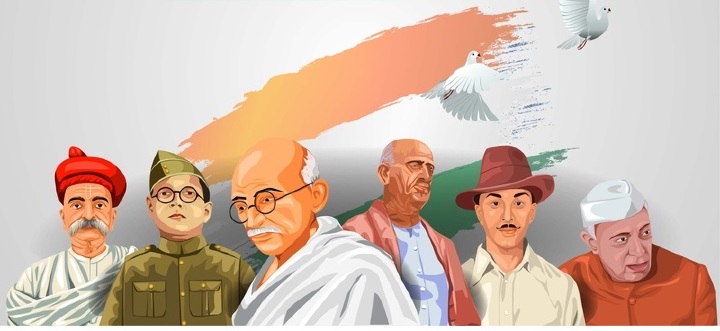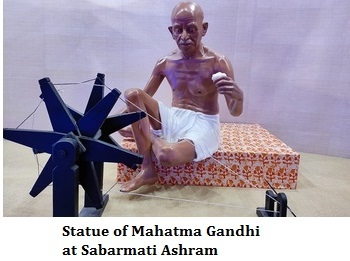

Indian nationalism is a form of territorial nationalism that embraces all of India's people, regardless of their racial, linguistic, or religious heritage. The origins of Indian nationalism may be found in pre-colonial India, but they were fully developed during the war for Indian independence from British rule. These coordinated anti-colonial alliances and activities helped Indian nationalism gain momentum in India. The Indian nationalist movement was led by personalities from the independence struggle such as Mahatma Gandhi and Jawaharlal Nehru.

Heroes of Indian Nationalist Movements
An illustration showing freedom fighters of India
The following points are the major factors that gave rise to Indian Nationalism

The political oppression of the Indian people by the British during its development is an extremely noticeable aspect of Indian nationalism. The highly developed British country fundamentally altered Indian society's economic structure for its purposes.
British developed a centralized government, as well as sophisticated institutions including modern schools and communications systems. This led to the emergence of new social classes and the unleashing of distinct social forces. These socioeconomic forces, which by their very nature were in opposition to British Imperialism, served as the foundation and driving force behind the emergence and growth of Indian nationalism.
Both Indian and international academics have developed several unique conceptualizations of Indian nationalism. Most historians and sociologists share this perspective, which places the growth of nationalism in the context of British colonialism and the distortions it brought about in our society's social structure and ideology.
These distortions speak to the social, cultural, and economic policies of the nationalist leadership and their class nature. These colonial distortions are considered to have had a role in the emergence of communalism, the division of the nation, and the survival of community politics even after independence.
Through subversives, colonial interaction created social and economic factors that sparked nationalism and national movements in Indian culture.
Nationalism is a historical process and a by-product of a confluence of social factors that strengthen links not just quantitatively but also qualitatively. Therefore, nationalism is an organic historical process by which civilized civilizations reinforce themselves through internal qualitative diversity and superior organic integration within a geographical limit.
The British government's Christian ministry and English education were the three main sources of colonial influence on Indian society. The British government replaced the native management system and government. This mission was intended to convert the Indians to Christianity.
British educators sought to spread education to change the way indigenous peoples saw things. The British community in India also influenced people in different parts of the country. Ports, cities and coastal areas were more affected, at least in the early days of the British Indian Empire.
The emergence of a national consciousness, recognition of the value of the organization and the importance of agitation led to the establishment of the Indian National Congress in 1885. The formation of parliament was a strong foundation of Indian nationalism.
Indian nationalism grew and flourished under a convoluted and odd social environment. It has undergone many stages of development. Its social base widened as it transitioned from one phase to the next, and its goal became more definite and audacious. Its modes of expression diversified.
The rising strata of the Indian population developed a national consciousness and vision because of the influence of factors affecting both Indian and global development, and they were attracted to the nationalist movement.
New classes gradually organized themselves on a national level and launched numerous movements as the nationalist movement evolved and gained momentum to eliminate the barriers preventing their development.
The growth of Indian Nationalism can be traced down into five phases marked by some revolutionary changes in the society and political scenario.
The socioeconomic foundation of Indian nationalism was quite limited. The British constructed new educational institutions in India throughout the first half of the nineteenth century, and it was these institutions that provided the modern education that gave rise to the Intelligentsia.
The Indian National Congress rose to prominence in 1885, capping the first phase, which lasted until that year. The second phase spanned roughly the years 1885 to 1905.
The third stage of the nationalist movement's growth lasted from 1905 to 1918. The Extremists replaced the Liberals during this period as the nationalist movement gained traction.
The fourth stage of the Indian nationalist movement's development began in 1918 and generally lasted till the Civil Disobedience Movement. During this era, the nationalist movement developed a sizable mass base and added direct mass action to its toolbox, which was a startling development.
This phase spans the years 1934 through 1939, the year of the start of World War II. During this time, a lot of novel developments occurred. The Congress Socialist Party, which advocated the class-based organization of workers and peasants as the driving force behind the nationalist movement, was founded when a group of Congressmen lost faith in the philosophy, plans, and methods of Gandhi.
However, inside the nationalist movement, a fight for the movement's hegemony was escalating among the various socioeconomic strata. As they gained political awareness and independent organizational strength, the political organizations representing workers, Kisans, and the left-wing middle classes intensified their efforts to sway Congress's program and policies, which had previously been largely under the control of the capitalist class.
Q1. What factors affect nationalism?
Ans. Education, social media, cultural background, participation in organizations, parental employment, and membership in religious organisations are all elements that have an impact on nationalism.
Q2. What is difference between nationalism and patriotism?
Ans. Nationalism emphasizes the unity of the cultural past, including language and heritage, while patriotism is based on love for people with a focus on values and beliefs.
Q3. What factors support the rise of nationalism?
Ans. Economic exploitation, repressive colonialism, social and religious reform movements, rediscovery of India's past, the influence of Western education, the role of the press, and the development of rapid transportation and communication.